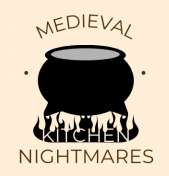We are very happy with how our experiential learning activity played out! Even if it was time consuming, it was a lot of fun to taste the different recipes, and we will definitely be remaking some dishes – like the Cinnamon Brewet and the Poudre Douce. That being said, there are always things that could have been done better when viewing our experience in hindsight. The main change would be our use of modern technology that likely affected the taste and texture profile of the food. We were very grateful for Nick’s food processor to grind the almonds and the breadcrumbs, but we missed out on the opportunity to really experience the demanding physical work of Medieval cooking. Our arms and hands were already aching after a couple of minutes, so we can’t imagine having to push through for 3 cups of almonds and 1 cup of breadcrumbs, on top of all the spices! We also used pre-ground cinnamon, nutmeg, and sandalwood, which might have affected the strength in flavours. Because of this, we also can’t testify to the true amount of time needed for the Apple muse and Almond milk – two dishes that would have spoiled very quickly. In addition, a hearth and stew pot would have enabled us to cook the stock and Cinnamon Brewet overnight (unsupervised), which would have augmented the flavour and tenderness of the meat.
Fowl roasting on a spit. A shallow basin collects the drippings to use in sauces or for basting; The Decameron, Flanders, 1432. CC Image source: Wikimedia. https://en.wikipedia.org/wiki/File:Decameron_1432-cooking_on_spit.jpg
Unlike modern cookbooks written for novices, Medieval cookbooks were generally written with the intended audience being an already experienced chef. As ⅔ of our group cannot be called experienced cooks by any stretch of the imagination, we struggled a bit with interpretation even before factoring some of the archaic language and phrasing used. With much of the recipe, especially for the Cinnamon Brewet, we were happy for Nick’s expertise in interpreting the instructions. This needed interpretation based on personal experience however, means that we may not have followed the instructions exactly as the original author intended.
We chose to make our own bread, something that would have been accurate for a large scale kitchen but maybe not for a more intimate personal kitchen. Most people were not equipped with the necessary equipment to grind flour, nor did everyone have an oven suited to baking bread. In the modern day it is much more expensive to buy rye ‘artisanal’ bread than it is to buy processed white bread, a complete flip of the reality in Medieval times (Kuropatnicki, 2009).
Image from Medievalists.net https://www.medievalists.net/2013/07/bread-in-the-middle-ages/
In conclusion, this experimental project showed us how easy we have it in our modern kitchens; with our powdered spices, pre-made broths and milks, and convenient ovens. The Medieval kitchen, while definitely functional and capable of producing good meals, required more time and work from the cooks. The question of availability also comes into play. For us, finding saffron, galangal, or cinnamon is a quick trip to the store in our car or an order on Amazon. In Medieval France, the more exotic spices were over sea and land, with individuals having to go to the market, walking or on horseback. A process that most likely took months, if not years, whereas now, something coming directly from Africa can do the distance in under forty-eight hours. For future projects, it would be interesting to try Medieval recipes from different regions (outside of Europe) and periods within the Middle Ages.
Thanks for joining us on our culinary journey to Medieval France!
Reference:
Kuropatnicki, A. K. (2009). English Nobleman’s Bread. Bread in Later Medieval and Tudor England. Studies in Foreign Language, 1, 49-73.
